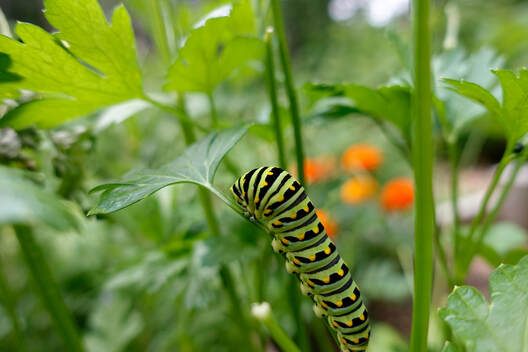|
I’m usually frustrated when I find that something has eaten a plant in my garden. Not so this week when I discovered Parsleyworms on my parsley. Adults are known as Black Swallowtail, one of our larger butterflies. According to Jeffrey Glassberg’s Butterflies of North America, you can recognize a swallowtail when you see a large butterfly that is not orange and has a tail. His book goes on to say that most butterflies are small to medium-sized and most large non-swallowtails are orange-colored with no tails. Back to the Parsleyworms. As you can see in the above photo, they are munching away on my parsley. They have pretty much eaten most of the curly-leafed variety leaving the flat-leafed Italian variety for a later snack. There are currently about five caterpillars on my one curly and one flat-leafed parsleys. Not much left for me, but they appear to be in the final stage of their development given the coloration so I may get some later. Next up they will crawl away to a support of a limb or post and pupate to later become a butterfly.
That’s when they will hopefully find plenty of nectar in my nearby garden from zinnias, lilies, calendula, bachelor buttons and other annuals. It might be that my parsley will have recovered enough for a second generation to be fed. Check out this UW Extension Horticulture article on Black swallowtail, Papilio polyxenes. Author & Photo: Sue Reinardy, UW Extension Master Gardener Volunteer
0 Comments
Leave a Reply. |
|
| North Country MGV | gARDEN bLOGS |
Location |
|

 RSS Feed
RSS Feed